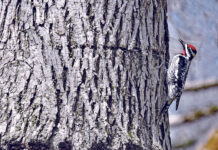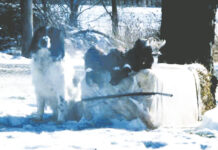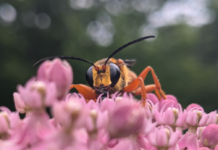When it comes to the sport of fishing, Kent, Ohio, can lay claim to lots of hometown fame, but none more lasting or more significant than a small bug created by William H. Schumman.
It’s a certain fact that Schumman, or more specifically his sponge rubber cricket, could and perhaps should be blamed for the demise of millions of innocent bluegills, the most well known and most colorful of all the world’s pan fish.
While largemouth bass and toothy walleyes get all the attention in today’s media driven world, it was a much simpler time and a more common and less glamorous target that interested Schumman some 80 years ago when he might have coined the phrase KISS, or keep it simple stupid.
It was that long ago when Schumman, surely an avid fly fisherman, sat at his fly tying vise perfecting a bug that looks like a fishy meal waiting to happen, something that a common bluegill couldn’t refuse or resist.
Surely, W.H. Schumman whipped up a series of bugs fashioned of thread, yarns, and possibly some pieces and parts of feather and fur, but in the end he must have leaned back in his chair admiring his final product in its finished form.
Patented
So pleased and proud of his lovely cricket, made sturdy and deadly, of rubber and, well, more rubber, that Schumman submitted his bug to the U.S. Patent office in the mid-1930s and did in fact receive a protective patent in 1940 for what he then called his Schumman’s Water Cricket.
One can only imagine the glee of patent attorneys and investigators who felt the need to field test a few of Schumman’s submitted samples just to be sure of his claim.
At the time, Schumman created the Cricket by mating a small hunk of sponge rubber and a tiny hook, then wrapping a few strands of squiggly rubber feelers, or legs, around the body. Done.
Simple and doable
If that sounds simple and doable, it was and still is. I once took a fly tying course on the hope that I too could manufacture such goodies as brightly feathered streamers, deer hair poppers and versatile wooly buggers. But graced with 10 thumbs and no patience, I failed all attempts at the art. Except that is, in wrapping up a few dozen Schumman Cricket look-alikes.
Instead of sitting for hours inventing trout patterns and fancy named bugs that all ended up all looking the same and lasting only until coming in contact with water, I could actually use and abuse my rubber Crickets. In fact, I still do.
It’s often been said that fly tying is perhaps the most perfect example of functional art. But built for its only mission, Schumman Water Crickets, which by the way, are still available and still imitated, are just as good and just as effective as ever.
And talk about functional. A Schumman Cricket can be fished as surface lure or a wet lure simply by squeezing the fake insect, letting water fill the voids in the foam, and thus sinking it.
Prime season
The next few weeks are prime Cricket season, a time when adult bluegills fan out hubcap size divots in shallow water where they perform springtime spawning rituals.
A smart angler can gently drop a Cricket on the surface, wiggle its spiny legs ever so lightly and wait just seconds for the water to open with the rush a bluegill to grab the rubber insect.
It’s a game best played with a light fly rod and wide smile.














we receive the Farm and Dairy news paper. We read the article about Schumman”s water cricket. Where can w buy them?
Bill Schumann’s fly shot was on North Mantua St. in Kent when I was a kid of 12 and delivered the Kent Record – Courier to his shop. He always wanted to pay his paper bill with flies. Some days I made his delivery my last so I could stand in the production shop doorway and watch the ladies assemble the components into a finished product. They worked ‘peace’ work, only paid fully for perfect flies. Seconds were sold by the handful in paper bags. That was what I could afford. Bluegill flies may be Schumann’s most famous but he had hundreds of fly patterns, especially for trout and bass. I can remember some flies being four to six inches long with big long streamer Hackel. Floating flies were made of closed cell foam rubber and wet fly bodies of open cell sponge. Those were great days.
Where can I buy the Schumman water cricket? My dad is 96 years old and wants one or two. He fished with them more then 50 years ago.
I am the grandson of Robert Schumann. W H is my great grandfather i still have some of the original flies still in packages. I loved going to the kent shop. My mom and aunt worked there.
I would like to purchase some of these water crickets. I fished with these as a boy years ago. Would like some for my children too.
I have a Schumann’s Lure, Wet Water Cricket, still in the unopened Yellow and Blue package. I would like to know the value of this older Lure? I would be happy to send pictures.